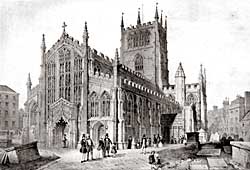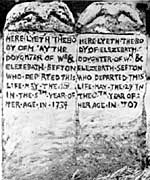< Previous | Contents | Next >
St Mary's churchyard

St Mary's church, c.1850.
St. Mary's Churchyard, surrounded as it is nowadays by high warehouses and left isolated in the midst of industrialism, is a grim and rather dispiriting place, but nevertheless it is a place which is full of interest and memories, being the heart and centre of the religious life of mediaeval Nottingham. The eye of faith can readily visualise it as it must have appeared down to 1792, for up to that time it was surrounded, not by great warehouses but by the magnificent mansions and gardens of the opulent citizens of Nottingham and of the different houses of the great county families who used Nottingham as a sort of metropolis to which to resort for relaxation and amusement when boredom overtook them in their country estates. Down to the close of the 18th century the north side of St. Mary's Churchyard was quite open and was entered by stiles, and I think that the whole appearance must have been very similar to that which is presented to-day by the great churchyard of Southwell Minster.
Archaeologists tell us that the site upon which St. Mary's Church and Churchyard stand has been used for religious purposes since time immemorial, and that upon it probably stood pagan temples and Saxon churches. If this is true, they have left no marks whatever and the only knowledge that we have of a church here before the Conquest is an indirect one. We know that in 930, during the reign of Athelstan, there was a Witenagemot, or council of wise men, held in Nottingham which was attended by an archbishop and sixteen bishops, so it is likely that with all these clergy present there would be some sort of church. The architecture of the time was very uncouth, and such a church if it had existed would be either a rough stone structure or more likely a wooden construction re-inforced with daub and the whole thatched, rather than roofed, but all this is purely supposition and we will leave the ancient church on one side for a moment and consider some of the memories associated with the present building and its surroundings.
St. Mary's Churchyard was not always the carefully preserved enclosure that we now value. In ancient days churchyards were used for all sorts of purposes which we should regard as very strange. Merry-making and church ales were held within its borders, and no doubt archery would be practiced there on Sundays and Holy Days. I have never yet come across any marks of arrows in the older portions of St. Mary's, but it is no uncommon thing to discover stones which have been rubbed down in sharpening arrow tips still remaining in the walls of ancient churches. This use for profane purposes of St. Mary's Churchyard was carried to excess and eventually roused the indignation of the Mickleton Jury, a body which was charged with the general oversight of the decorum and well-being of the mediaeval town, and we find that on October 12th, 1629, they prosecuted a certain Anne Hind for "wilfully putting her swine into the churchyard, whereof she deserves great punishment." She was fined sixpence. The present palings round St. Mary's Churchyard were erected in 1807, and it is interesting to remember that the lamp-holders at the south-east and north-west entrances are the only two remains that we have of the old public lighting system of Nottingham. We have several examples of private lamp-holders, but these are the only public ones that are left. The iron circle in each of them would carry a globular vessel of thick glass which would be filled with whale oil upon which a wick would float, whose light would, I suppose, do something to dispel darkness and gloom of ancient Nottingham.
There are about six hundred memorials still existing in St. Mary's Churchyard, the oldest of which dates back as far as 1704. The churchyard was closed for burials, except in vaults, in 1856 and the last interment was in 1889. There is only one cross in the whole of the churchyard, which is rather a curious comment upon the classic tastes of our forefathers, and although there are a number of interesting memorials their beauties pale before the fine head-stones which may be studied in St. Nicholas' Churchyard. There are a few Swithland slate head-stones which can be readily distinguished by the roughness of their backs and the beauty of their lettering. These tomb-stones were made at Swithland, in Leicestershire, from slate obtained in the local quarries and they were wrought in the bad weather of winter, when out-door work was impossible by the quarrymen of the district. In a humble way they appear to have formed a regular school of craftsmen who maintained to a certain extent the high artistic traditions of the Nottingham School of Alabaster Carvers or the York School of Masons in early days, and really some of these head-stones are artistic triumphs, if one takes the trouble to attune one's mind to the curious classical outlook of contemporary taste.
A glance at the churchyard brings home the fact that there are a good many table tombs, and still more great heavy slab tombs within its borders. These, to our mind, are ugly and unsightly, but at the time they were erected they were intensely practical. We have seen something of the mental misery brought about by the action of the body-snatchers, or resurrection men, and these tombs are the answer which the relatives of the deceased gave to these gentry. Of course the safest way to protect a body was to bury it inside the church, and so we get a vast number of interments in our churches during the XVIII. and early XIX. centuries, a horribly unhygienic custom. But still there were many for whom no room could be found within the safe and consecrated walls, and so to preserve them from disturbance brick vaults were constructed, closed either with heavy stone slabs or with table tombs which could not be moved without considerable noise, which noise would defeat the intentions of the thieves.

Terracotta gravestone in St Mary's church, c.1920.
A close survey of the epitaphs in the churchyard does not display any outstanding feature of great interest, unless perhaps it is the fact that there are a good many military tombs which reflect the time when Nottingham was a garrison town with its barracks on the upper side of Nottingham Park. But one can glean quite a lot of Nottingham's past and of its life during the Georgian days by noting the names and professions of some of the deceased. A unique tombstone will be found close to the north-west door, in very rough letters commemorating the "Daughters of William and Elizabeth Sefton," who died in 1704. Sefton was a manufacturer of earthen pipes, and this tombstone is earthenware. He seems to have roughed out a tombstone in the clay which he used for his trade, impressed the lettering as well as he could, and baked the whole thing into terracotta in his own oven. I have never come across a similar tombstone elsewhere.
Mrs. Waterhill, who died in 1775 and was buried near the south door, must have been an extraordinary lady. She was a widow and died at the age of 79 in her house upon High Pavement. During her life she had held extraordinary views with regard to the observance of the Sabbath, which she maintained ought to be observed on the Saturday after the Jewish custom, to which end she used to put on her best clothes and attend services in St. Mary's Church on Saturday, and devoted the whole of that day to deeds of good. However, to be on the right side, she used to go to church again on Sunday, but in order to mark the difference, on Sundays she only came in her second best clothes and spent the rest of the day in ordinary domestic occupations. I know nothing of Mr. Waterhill, but apparently his treatment of his wife caused her to dislike men for according to her own arrangement her funeral was carried out as far as possible by women. Six unfortunate ladies dressed in white struggled with her coffin and bore it from her house to her grave, and as far as possible the whole of her obsequies were carried out by women, and at the conclusion of the ceremony a merry peal of seven bells, one for each day of the week, was rung from the tower of St. Mary's Church.
Almost opposite the south porch is a brass plate laid into a table-tomb with the inscription "Mary, wife of George Winterbottom, Poet, died April 10th, 1826, Aged 33." I have never been able to find out any of the works of this poet, and it seems an extraordinary thing to have thus commemorated his powers upon this tombstone.
